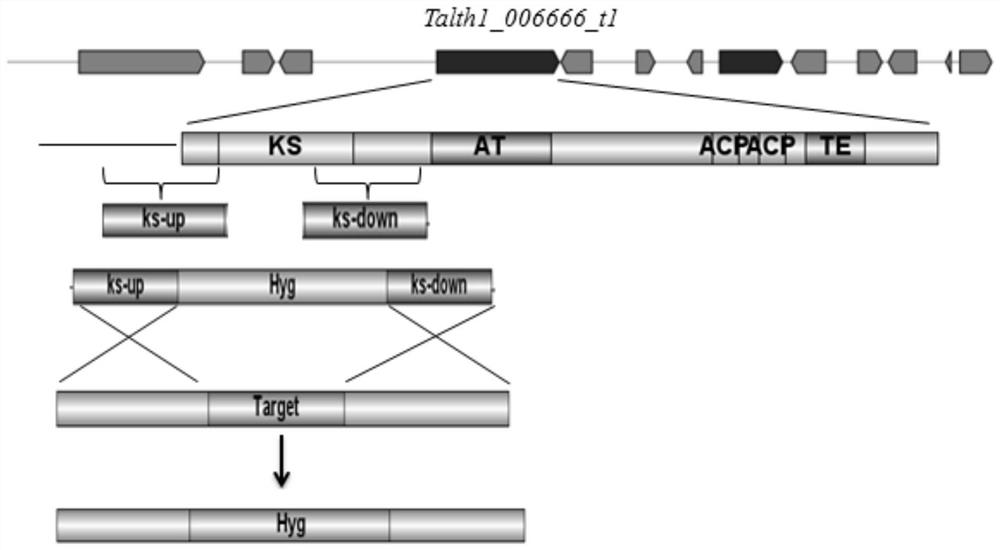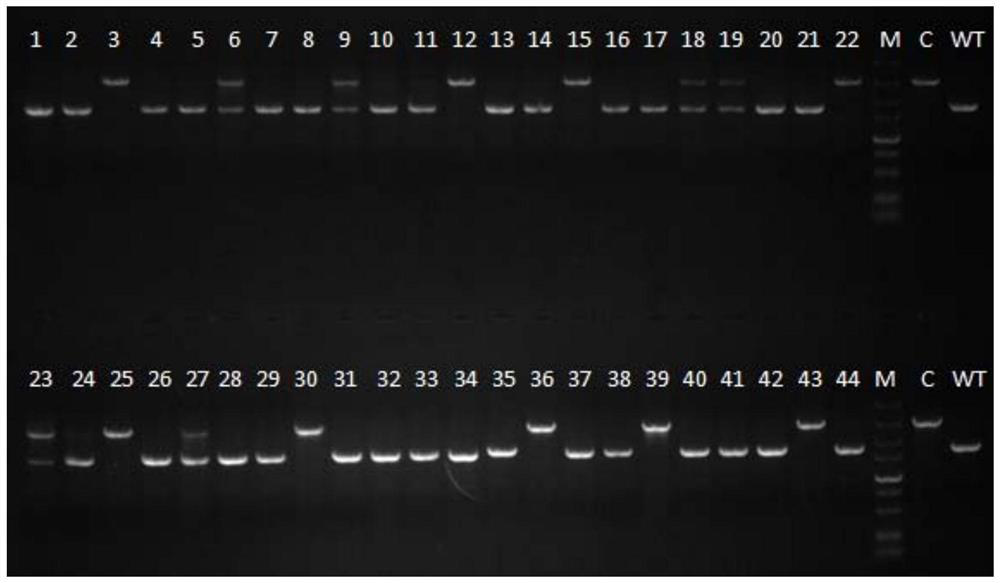A method for obtaining positive transformants of thermophilic fungi
A transformant, fungal technology, applied in microorganism-based methods, biochemical equipment and methods, fungi, etc., can solve problems such as target compound discovery, in-depth study of biosynthetic pathways, rational design and directional synthesis difficulties, etc. Beneficial for large-scale and high-throughput screening work
- Summary
- Abstract
- Description
- Claims
- Application Information
AI Technical Summary
Problems solved by technology
Method used
Image
Examples
Embodiment 1
[0066] Construction of knockout plasmids
[0067]The full-length knockout fragment (SEQ ID No.1) was constructed by constructing homologous recombination to inactivate the key functional domain KS in the gene Talth1_006666_t1 encoding PKS in the genome of Dupont thermophila NRRL 2155.
[0068] Using the thermophilic Dupont bacteria NRRL 2155 genome as a template, the upstream homology arm fragment and the downstream homology arm fragment of the KS gene in Talth1_006666_t1 were obtained by PCR method, wherein KS31up-F (SEQ ID No.2, 5' end contains SbfI restriction site, the restriction site and its upstream (5' end direction) 25bp and the pPK2.SUR.eGFP vector after digestion with SbfI (given to Liang Lianming, State Key Laboratory of Biological Resources Utilization and Conservation, Yunnan Associate researcher) sequence overlapping at one end) and KS31up-R (SEQ ID No.3, 5' end contains a 20bp DNA sequence overlapping with the hygromycin resistance gene expression cassette frag...
Embodiment 2
[0070] By constructing the full-length homologous recombination knockout fragment (SEQ ID No.10), the key functional domain KS in the gene Talth1_002859_t1 encoding PKS in the genome of Dupont thermophila NRRL 2155 was inactivated.
[0071] Using the Dupont thermophilic NRRL 2155 genome as a template, the upstream and downstream homology arm fragments of the KS gene in Talth1_002859_t1 were obtained by PCR, wherein, KS12up-F (SEQ ID No.11, 5' end contains the Sbf I restriction site point, the restriction site and its upstream (5' end direction) 25bp overlap with the 25bp sequence at one end of the pPK2.SUR.eGFP vector after digestion with Sbf I) and KS12up-R (SEQ ID No.12, 5' The 25bp DNA sequence overlapping with the hygromycin gene expression cassette at the end) was used as a primer pair to carry out PCR to obtain the upstream homology arm fragment of the KS gene in Talth1_002859_t1, and the KS12down-F (SEQ ID No.13, 5' end containing and anti-hygromycin Hygromycin gene exp...
Embodiment 3
[0073] Preparation of protoplasts from Dupontella thermophile NRRL 2155
[0074] (1) Inoculate the mycelium block of Dupont thermophilic bacteria NRRL 2155 in the center of the PDA medium, and place it in an incubator at 45°C for 7 days. Use 1mL pipette tip and sterile water (add 0.05% Tween 20) to scrape the culture from the above plate, filter with four layers of lens paper, and divide the liquid containing spores into 1.5mL centrifuge tubes, 10000rpm , enrich the spores by centrifugation at room temperature for 5 minutes, discard the supernatant, and enrich to 10 8 cells / mL and washed twice with sterile water.
[0075] (2) Transfer 200 μL of the spore suspension to 100 mL of YPS liquid medium, culture at 45° C. and shake at 180 rpm for 20 h.
[0076] (3) Pour the mycelium cultivated in step (2) into a sterile funnel (containing four layers of lens-cleaning paper) and filter to collect the mycelium.
[0077] (4) Wash the mycelia twice with P buffer solution.
[0078] (5)...
PUM
 Login to View More
Login to View More Abstract
Description
Claims
Application Information
 Login to View More
Login to View More - R&D
- Intellectual Property
- Life Sciences
- Materials
- Tech Scout
- Unparalleled Data Quality
- Higher Quality Content
- 60% Fewer Hallucinations
Browse by: Latest US Patents, China's latest patents, Technical Efficacy Thesaurus, Application Domain, Technology Topic, Popular Technical Reports.
© 2025 PatSnap. All rights reserved.Legal|Privacy policy|Modern Slavery Act Transparency Statement|Sitemap|About US| Contact US: help@patsnap.com



